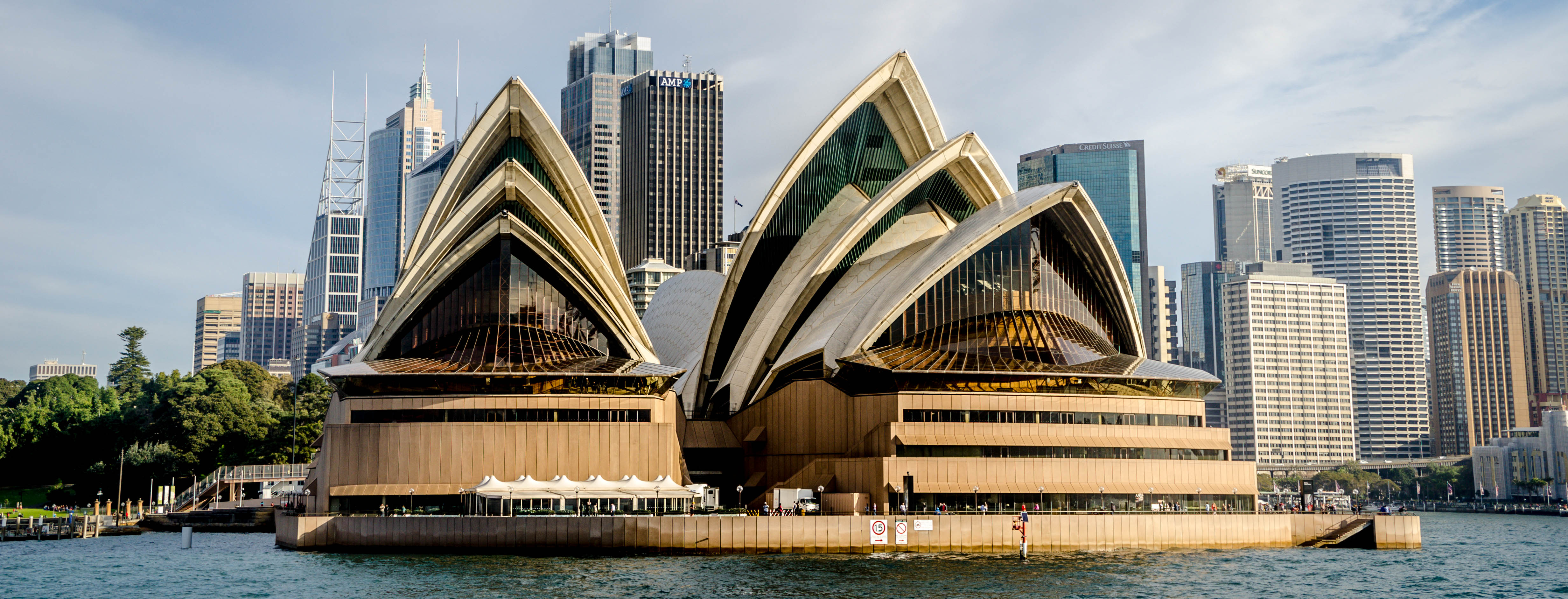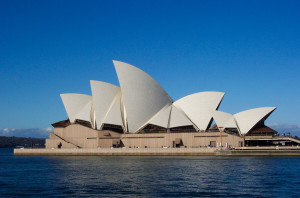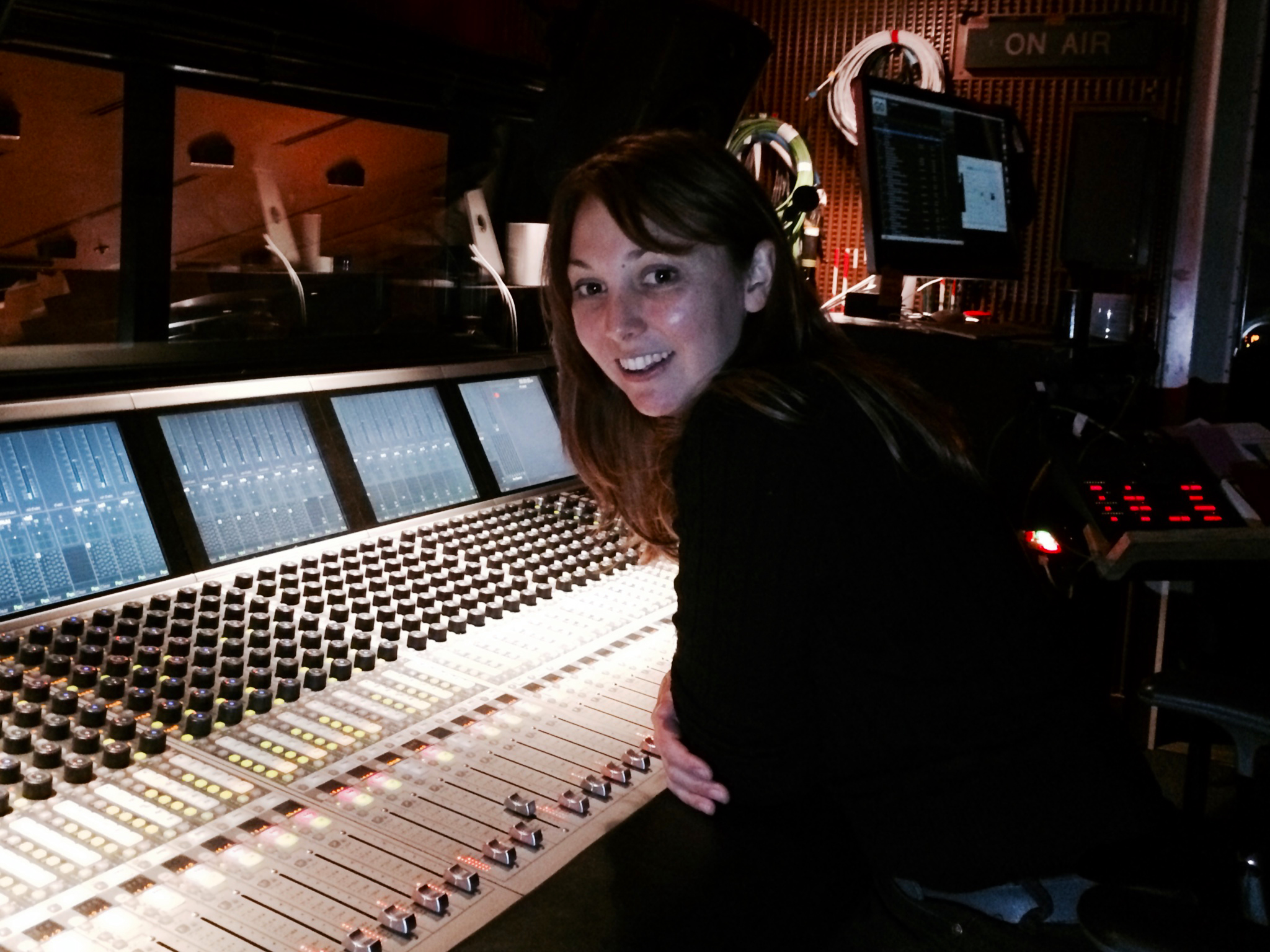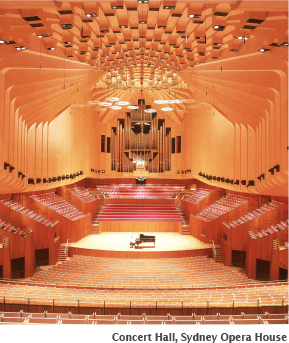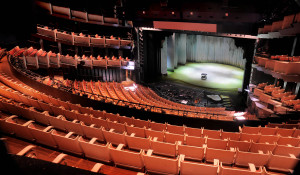By: Karrie Keyes
The Sydney Opera house is an iconic performing arts center in Sydney, Australia. It was designed by Danish architect Jorn Utzon and opened in October 1973. The first performance was the Australian Opera’s production of War and Peace. The Syndey Opera House cost over one million Australian dollars to build. The Sydney Opera House hosts over 3000 events each year with over two million people attending, and provides guided tours to over 200,000. It is 185 meters long and 120 meters wide, has 2194 pre-cast concrete sections in the roof, with sections weighing up to 15 tons. There roof is held together with 350 km of tensioned steel cable and has over one million tiles. There are 6225 square meters of glass and 645 kilometers of electric cable. The Sydney Opera House has 1000 rooms.
They Sydney Opera House is the focal point of Sydney Harbor and is an international architectural icon . In 2007, UNESCO recognized the Sydney Opera House as one of the most outstanding places on Earth with its inclusion on the UNESCO World Heritage List.
There are seven women working on the sound crew at the Sydney Opera House. SoundGirls.Org caught up with one of them Sarah Black to find out what it’s like to work at an extremely busy and iconic performing arts center. In the coming weeks we will meet more of the Sound Girls at the Syndey Opera House.
Meet Sarah Black –
Music has always been my thing, both as a sanctuary and for community. At university I studied Digital Media at UNSW College of Fine Arts with an honours year where I majored in audio (studio). After finishing I found it hard to get a good job and ended up with several dodgy ones instead. I was lucky enough to meet an engineer called Darren Robinson at one of those shitty jobs. By this point, 2006, I was busting to actually mix bands and constantly trying to prove myself. The first time I met Darren I helped him load some wedges that weighed about half my weight into the back of a truck, and so he decided to give me a chance and let me follow him around to the venues he was mixing at.
After hanging around for long enough I started off mixing Monday nights at the Hopetoun Hotel, which was a bit of an institution and rite of passage for Sydney bands at that time. My first solo gig I was so nervous I couldn’t eat the whole day leading up to it. A good friend sent me a text message during sound check that just said ‘Don’t fuck it up’. It must have gone alright as I ended up on their list of regular engineers. At the time I remember Darren often saying ‘these are the good old days’ and in a lot of respects they really were.
Not long after that, Darren was stuck finding someone for another venue he was looking after on Oxford St called Spectrum and so I got the call. This was about a 350px capacity, rough as guts, rock and roll venue. The roof used to drip right next to the console so every time you were patching something or getting in and out from behind the console it was like water torture. Part of the payment to the sound crew was drink vouchers. I ended up being in house there for about three years. This is where I really got my mixing chops up as well as learnt to assert myself. I freelanced a bit in this time too doing FOH for bands and other venues occasionally.
Then Spectrum went through renovations and around that time I started working at the Sydney Opera House. Three years later I’ve learned a whole lot more about things that I didn’t even know existed and had some great experiences with some awesome people. I’ve mixed the Sydney Symphony Orchestra in the Concert Hall, done FOH systems for the Dirty Three who are one of my all time favourite bands and right now am in the control room for this years Opera Australia seasons of Rigoletto and Don Giovanni. Always trying my very best not to fuck it up.
The Sydney Opera House
How many venues are contained under the one roof?
There are two main rooms, the Joan Sutherland Theatre (formerly the Opera Theatre) and the Concert Hall. We then have three smaller theatres, the Playhouse, the Studio and the Drama Theatre. There are a few additional spaces that get transformed into venues as required including the Utzon Room, all the Foyers, Bennelong restaurant and a marquee that is located on the northern point. We have a recording and broadcast department that pushes the boundaries of all these venues out from under the roof.
Another performance space is the Forecourt. This is at the southern end of the SOH and looks out to the Botanical Gardens as well as the harbour. It’s a beautiful place to see a show when the weather turns it on. One of my favourite shows I saw there was Massive Attack in 2010. Recently The National performed there and that was streamed live to the internet. Since then, the video has been loaded by unique ids more than 600 000 times.
What are the sizes of the venues?
The Concert Hall has 2679 seats in total including the choir stalls and some boxes that are behind the stage. For most amplified performances this seating capacity reduces to about 2100 as those areas are blocked out.
The Joan Sutherland Theater (JST) seated capacity is 1507
The Drama Theatre is 544, the Playhouse is 398. The Studio has different capacities dependant on configuration. Standing it is licensed to hold 600, though seated it ranges between 220 and 350. The Utzon Room holds about 200 and the Forecourt approximately 6000.
Are there sound systems installed in each venue?
The JST has a mixture of Meyer and D&B speakers for FOH, including installed surrounds and delays. This is set up with a LCR configuration. There are centre arrays, with Q7s and Q10s for left and right. As there are several loges and an upper circle area there are speakers that provide specific coverage of those areas. The JST uses several lake processors and has a Euphonix System 5 in the control room. There are installed foldback speakers, both on stage (mostly Meyer) and in the orchestra pit (Fostex). Orchestral microphones we use include Sennheiser 8040s and 8050s, TLM 170s, KM 140s and 150s.
The Concert Hall as a standard set up has main left and right line arrays that are made up of D&B J8s and J12s divided into three zones. There are also delays for the upper circle and six T10 arrays for the side boxes and choir stalls. There are image speakers that provide coverage for the front of the stalls. If it is just for SM announcements we use Q10s on either side of stage. There are also temporary ground stacks we use that include J subs and J8s, along with E3s for front fill. Previously there was a Midas Heritage3000 as the installed console, though this was replaced with an XL8 about 2 years ago. The main FOH ops position requires removing seats at the centre rear of the stalls, and then the desk riser comes out of the wall on a lift. It’s pretty cool. There is also a floor riser if you aren’t using the XL8.
The Concert Hall is a really live room, with a really high ceiling. For amplified shows it really helps to have an acoustic canopy in place. This is usually in the form of drapes. There are also donuts above the stage that move on winch lines to act as acoustic treatment.
For monitor systems, it depends on the show requirements. In the past we have used Pro9, Pro 2, PM5D etc. consoles, with D12s and M4 speakers. There is an orchestral microphones drawers packer as well as a ‘rock’ one.
The Drama Theatre has a combination of D&B speakers, including Q7s, E12s, E8s, E6s and J-Infra subs. There is a main left, right, subs, delays and surround speakers. In addition, due to the width of the stage across the room, there are several speakers rigged along bars in front of the stage to provide even coverage and imaging. The Drama Theatre system uses Nexus and R1 software. Recently there has been a Midas Pro9 installed that can either be used in the control room or at a mix position at the centre rear of the auditorium.
The Playhouse also has D&B speakers for most of the FOH PA. There are centre speakers as well as left, right, sub, front fill, delay and surrounds. The Playhouse has a Pro2c that can be used in a control room or brought into the auditorium. The latter is definitely best for live music.
The Studio has a Pro2 as the standard console, Q1 arrays, J Subs and Q10s for image. There is also front fill and speakers to cover the sides and rear of the gallery level. This all moves about depending on the show. For example, a regular summer show that runs is La Soiree which is set in the round. Speakers are positioned accordingly to give coverage around the room.
Monitors for all the venues float and our stock includes M4s, EAWs and martins. For orchestral foldback we usually use Fostex speakers.
All the venues also have fibre patching and routing through Nexus that allows transporting to our recording and broadcast studios as well as for program feeds throughout the foyers and dressing rooms.
Sometimes I laugh about where I’ve mixed in the past, you know in a dingy pub and the PA was half behind the stage and of the 12 lines coming off stage only 10 worked, eons for monitors that all had different speakers because they’d been blown and replaced with mismatched ones… and the mics were 57 knock offs… and you’d bust your ass to get it sounding decent. Now in some of the venues you just turn it up and it sounds great effortlessly. I wonder if I’d know how to tune anything if I started in such a luxurious place!
What types of performances are in each of the venues?
All the venues are adapted to a variety of shows, and most shows requires some level of customisation in terms of the sound system and audio requirements.
Opera Australia and the Australian Ballet, two of the main resident companies, rotate throughout the Joan Sutherland Theatre. Each of these companies has several seasons throughout the year that last a couple of months. Opera Australia includes musicals as well as traditional opera in their programming. During the opera season there is an orchestra pit in use that extends under the stage. The front section of this pit raises up to create a larger stage for the Ballet season.
For Vivid, the Joan Sutherland Theatre is transformed into a more traditional music venue with a modified PA. Last year Kraftwerk were one of the highlights of Vivid. For their shows a PA was installed that used Iosono processing. This meant something like an additional 72 speakers were rigged around the room, and there were 42 discreet outputs, which allowed for incredible spatial sound image. It really breaks away from a traditional left/right mixing formula for bands. They also had a 3D lightshow which was pretty awesome and meant everyone in the audience was wearing 3D glasses.
Iosono was also used a couple of years ago for the Opera Australia’s Die tote Stadt (The Dead City). This was pretty amazing. Again multiple D&B speakers were set up around the JST. Iosono was used to create a surround sound system, almost mapping out the orchestra with different sends so that you felt like you were immersed amongst the musicians. The orchestra was so large it wouldn’t fit in the pit under the stage and so was actually set up in the Studio venue. The audio was all patched to the recording studio which at the time was located next to the Studio venue, and then up to the JST control room, three floors above on the opposite side of the SOH. There was also a Euphonix bucket set up in the JST auditorium, connected via cat5. Out of control, right? Conductor view also had to be piped up to the JST stage with minimal latency.
The JST is also used for talks. There is a really great program that the SOH runs called Ideas at the House. They are several discussion and idea festivals throughout the year such as Festival of Dangerous Ideas and All About Women. This years FoDI is on 30th and 31st August and includes a conversation with Pussy Riot. Other one off events held in the JST have included guest speakers such as Noam Chomsky, a panel called The War on Whistleblowers and their Publishers featuring Julian Assange and a series called National Geographic Live! which features photographers and film makers talking about their work.
The principle resident companies that use the Concert Hall include the Sydney Symphony Orchestra, Australian Chamber Orchestra and the Sydney Philharmonia Choir. Along with their more traditional programming, the SSO regularly play the score to films that are shown. This is one of the few times the orchestra is actually fully amplified, mixed along with playback tracks of dialogue and sound effects. They have done the Lord of the Rings Trilogy, 2001: A Space Odyssey and Gladiator to name a few. The Concert Hall is also our main venue for larger touring and commercial performances including music, comedy and children’s shows.
The Drama Theatre has a fixed stage with raked seating banks. It is primarily used for theatrical and dance performances. It is most used by resident companies Bangarra Dance Theatre, Sydney Theatre Company, Bell Shakespeare and Sydney Festival. The Drama Theatre can be set with a revolve and has a flying system.
The main resident company using the Playhouse is Bell Shakespeare. Like the Drama Theatre, the Playhouse is a fixed stage with raked rows of seats. Aside from dramatic performances it is also used for comedy, film screenings, talks and children’s shows.
Along with the Playhouse and the Drama Theatre, you enter the Studio from the Western side of the SOH. The Studio has total flexibility in terms of stage configuration. There is no fixed stage. There are seating banks that can be extended out or it can be set for in the round performances. There is a mezzanine level that wraps around the room. It works really well for live music, cabaret and children’s shows. It’s actually one of the most enjoyable rooms to mix bands in the SOH, the acoustics are great and it has a sweet PA.
The Utzon Room is used for functions and receptions, corporate events, small scale musical performances as well as Kids at the House programming.
There are always a variety of other functions that occur at the SOH and fit into any and all of the venues, such as welcome ceremonies for visiting royalty and awards shows such as The Deadlys.
How many people are on the sound crew for the Opera House?
There are four supervisors and ten permanent or contracted technicians. There is a large pool of casuals, some more casual than others, around seven would be working in any given week. AV also falls under the sound umbrella. There are two contracted AV crew, including a supervisor, and three other regular casuals though again there is a larger pool. Then there is our Head of Department and Operations Supervisor.
How many women total?
Seven are regularly working, though we have some more that drop by occasionally.
What are your job duties?
Our duties include pretty much all aspects of putting shows on. We have a storeroom on site and a larger warehouse off site. Gear is usually booked for a gig, the warehouse staff prep it and we bump it in. Depending on the scale of the show, we create console files and make input/output patch lists prior to the gig. Sometimes bump ins are fairly straightforward and other times they require custom rigging of speakers and set up of equipment. We push packers where they need to go, plug things in and check systems. Some shows will have a week or more of production where you end up doing pretty long days of tech and rehearsal. Sometimes you might be required to help develop playback for shows on Qlab. Liaising with clients is a big part of our job, making them feel confident and comfortable. We mix shows. This can really vary in style and requirements between music and theatre so you need to be adaptable. For larger productions there might be touring engineers in which case we will handle systems (FOH, monitors) and stage. We are lucky that we get to move around all the venues so there is a lot of variety. We bump out too: rolling cables, pushing packers again… everything in reverse at three times the speed.
How are the gigs assigned?
Our operations supervisor looks after the rostering. Some technicians tend to have niches they really enjoy while others have very fluid roles. Generally if you are going to be put on a show run that lasts more than a week that will be discussed with you leading up to it, otherwise it’s a surprise!
How many gigs are typical per week?
Most nights at least half of the venues will have shows running, or production weeks taking place. Often there can be venue sharing, where one venue has more than one show over the course of the day. This can be pretty crazy when it’s big changeovers! Recently Neil Finn was playing three shows in the Concert Hall and every day the SSO were also using the venue. So each morning there would be a full orchestra set up, show/rehearsal, strike and then a touring rock and roll show loaded in, performed and struck. It is times like that you need to work fast and really be part of a team.
http://www.youtube.com/watch?v=K_Us3H72U4Q
There are a few quiet periods throughout the year but not many and they don’t seem to last long. Generally this time can be used for maintenance, training and improving systems.
What do you feel are the must have skills to work at the SOH?
You have to be a team player. One of the greatest things about working here is the solidarity; everyone helps each other and shares knowledge. It’s such a privilege to work in such an iconic venue so it’s important to take pride and have high standards. You need good manners as you often deal with high profile clients. Earlier this year I operated a lectern for HRH Prince William! A sense of humour is critical as is the ability to think fast and be able to troubleshoot under pressure…. oh and be able to roll cables. That trick never, ever gets old.
Favorite gig to work on?
Personally, I love the rock n roll shows! Sometimes during the gig, when I’m out at FOH or monitors, I can’t believe I’m getting paid for this.
